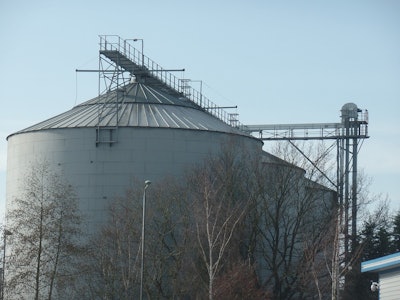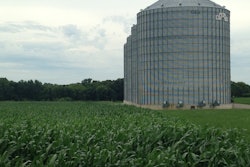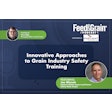
In part two of this series of the Feed & Grain Podcast, Steven Kilger engages in a discussion with Jeff McClure, vice president of Safety and Regulatory Affairs at National Grain and Feed Association (NGFA), and Joe Mlynek, content creation expert and partner at Safety Made Simple about grain dryer safety and maintenance.
The trio delves into NGFA's commitment to safety education, sharing valuable insights on where to find essential safety resources for individuals, employees and customers within the feed manufacturing and grain handling industries.
Transcript has been edited for clarity.
Steven Kilger: Hi everyone, my name is Steven Kilger. I'm the managing editor for Feed & Grain and host of the Feed & Grain Podcast. Thank you so much for joining me today as we dive deep into the issues affecting the feed manufacturing, grain handling, and allied industries. Today, I'm once again talking to Jeff McClure, vice president of Safety and Regulatory Affairs at the National Grain and Feed Association also known as NGFA, and Joe Mlynek, content creation expert and partner at Safety Made Simple and a consultant at NGFA. This is the second podcast with Jeff and Joe. This time we're discussing grain driver safety and maintenance along with NGFA's commitment to safety education, and where to find safety education materials for you, your employees, and your customers.
Before we start, if you're listening to this in a podcasting app, please rate us and subscribe. If you're listening online, sign up for the Feed & Grain newsletter Industry Watch to see the latest podcast and stay up to date with all the latest news from around the industry. Now onto the show.
Kilger: I was going through the website when I was preparing for this interview for the podcast, listeners I do prepare every time. But I was going to the NGFA website and you guys had a really great video that you had recently been reposted to the top, I think he made it years ago, but really important from this NGFA safety and grain quality management video. Can you talk a little bit about what's in this and why you guys would recommend people going and at least watching this to get a refresher on how to properly manage grain quality?
Jess McCluer: Sure, I think this really, Joe just described that process for maintaining quality, it really talks about that step by step. And it also has the animation to go with that. And it's designed not only for those grain elevator boys but it's also designed for farmers. So really, while there's, I would say no silver bullet for monitoring and managing grain storage. There are certain steps that I think everyone recommends. It's just as Joe described, it's preparing the grain beds, drying the grain to proper moisture content, optimizing aeration, controlling the temperature, and checking the grain frequently. Right. So that's what I would say the primary outline of the video. If you go on to our website, ngfa.org/ safety, you can have the opportunity to view it and see those steps that I talked about know a little bit more detail.
Kilger: Yeah, it's a great thing to send to your co-op members or your grain elevator customers, if you have a newsletter and haven't linked it, send people that way. Because sharing information is how we ultimately save lives. So really important. So we talked about, the grain bin itself. The other big issue, this time of year is grain dryer fires, especially with high moisture grain. Can you talk a little bit about how grain dryers contribute to preserving grain quality, and why they're important? And then what hazards do they actually introduce into the process?
Joe Mlynek: Yeah, so you know, as far as the quality permits, address moisture content, so that preserves the grain during during storage. So grain that's generally stored at high moisture, and temperature will spoil fast. It goes pretty bad. You know, the best comment ever heard about grain was actually at NGFA Convey some years ago, and a quality expert said, you know, once you put grain into a bin, the quality is not going to get any better. But we can preserve and prolong the life of it while it's in the bins. So, drying really prevents microbial growth, which can result in mold, and those types of things will then, in turn, increase the storage. But as far as potential hazards come to mind, one is grain dryer fires, which probably most of the listeners have seen pictures of. I've had a number of clients that have had those over the years. You can also have smoldering grain that could possibly enter into a grain storage structure which is never a good thing because that can cause fires in bins and also, consequently explosions and those types of things.
Kilger: Yeah, can you go a little more in-depth about kind of the common causes of dryer fire issues like plugging grain flow mechanical failures, what should people be on the lookout for?
Mlynek: Sure, you know clogged grain flow can result in small form grain or even foreign material within the dryer. This can result in the dryer fire or transfer of that smoldering or hot grain to a storage bin. So plugged grain is really the first thing that I've seen with some of our clients. And there are some things we can do about that to prevent those types of things. You can also have mechanical failures within the dryer itself. Could be like, the grain metering system or the unloading system, which is generally going to be augers or drags, that can also lead to grain dryer fires as well.
Kilger: Would you recommend some start-of-the-season maintenance overview of your grain dryer, especially if you're on a farm, and it maybe doesn't get used quite as often?
Mlynek: Preventive maintenance is really important. Again, I'll refer back to the NGFA safety tip sheets they have. The one on grain dryer fires really focuses on a couple of different things. But we know that preventive maintenance, probably, there's a lot of important things we need to do from a safety perspective at a grain elevator. But this, to me, it's one of the most important things, preventive maintenance. So a good PM program can reduce the potential for danger of fires, and downtime. And you want to make sure, that's important, especially when you're in the thick of it in the middle of harvest.
But the NGFA safety tip sheet hits the mark when it comes to grain dryer fires is concerned. It's right on point. One of the things that talks about is to have an annual inspection. That would be maybe from a manufacturer or even a dryer service provider. So I know, in August I was in the state of Michigan and one of my clients had an inspector out that was going through all of their dryers before the season started. There's also some pre-startup dryer maintenance as well, this is outlined. I'm not gonna go into all the details on that safety tip sheet on the NGFA website.
And then we have routine dryer maintenance. So that's really developing a cleaning schedule. And what the cleaning and the housekeeping efforts are really focusing on are fines that are on the floor, and the screens, which can reduce the airflow. That accumulation affects airflow within the columns and the grain dryer. Now, it's recommended by most manufacturers that you clean those probably, every 24 hours of operation. However, the best practice would be maybe cutting that in half and going with 12.
And then there's also extended shutdown maintenance. If you're going to be shutting down dryers for a period of time, you'd have some maintenance during that period of time. And it's simple things like making sure that the burners are covered with a tarp and those types of things, as well as cleaned out on a regular basis.
So I would also mention to just add in there, that I think that dryer fire response and having a plan is important. And I've written a blog on this before. But make that part of the emergency action plan. So, how do I respond to a grain dryer fire at my facility? What is the procedure for shutdown, and draining the columns? What type of personal protective equipment do people need to wear when they're doing that? How to isolate the gas flow, all those different types of things.
I had a client years ago, down in Louisiana that had a grain dryer fire. And when they had me on site, they said could you put together response procedures for all these? I said, sure, and I learned a lot. Each manufacturer has kind of a different procedure, this company has a bunch of different styles of dryers, from different manufacturers. It took some time, but afterward, we were in a much better position to train not only our employees but also have the responding fire departments out to talk about that type of thing happening at the facility and how they would address it when they had their fire. The fire department really didn't know anything about it and the best time to get to know your fire department is before something bad happens. So I would encourage people as well to have a dryer fire response plan as part of their emergency action plan.
Kilger: Very true. Always the best time to really get all this in place is before it's happening. You never want to be caught with no plan. For regulation purposes, if nothing else. How does NGFA make and plan to continue sharing safety resources? You guys have been doing a great job of it and you're expanding it all the time. What are kind of the plans for grain quality and safety features in the future? Are you going to cover this more on the website? What are you planning?
McCluer: Definitely, I think the information that we have is still mentioned we have safety topic sheets and videos on these topics and they're available on our website, free of charge. Doesn't matter if you're a member of NGFA, or if you're not, it's still available. We have tip sheets, we have recorded webinars, we have interactive training courses and guidance documents, and we have a wide range of items on our website that members can utilize. We also put information in a newsletter, as you may have seen. We had an article about this, and we're also going to be having an article about this very topic that will be in Feed & Grain's upcoming issue.
Also, I would say, we address these types of issues we're talking about, engulfment prevention and grain quality, during Harvest Safety Week and Stand Up 4 Grain Safety Week. So a wide range of of venues that we have, whether it be in person, whether it be online, whether it be publication, we utilize those resources to get this information out. And if you have any questions about this, please feel free to contact me or as Joe mentioned, he's a new member of the NGFA team.
If you want to contact Joe about that as well and look forward to some of the new projects that we'll be working on that might be addressing some of these targets as well. We'll keep everyone lingering to wait and see. But you know that is that something that may, that may come down the pipe later on.
Kilger: Keeping me in suspense. I'm also looking forward to seeing it and knowing what you guys produce. Especially Joe, he's going to come back on the podcast and talk about it, we're gonna make it happen. So where can listeners find more information and resources on the topic? On your website? I think there's a special area for it.
McCluer: Yes. If you go to ngfa.org/safety. In fact, one of our featured videos, right there on the safety section of our webpage, that you can look at talks about grain quality and safety. It's an animated video that we have on there. And then there are also tabs there that you can click on to go to what Joe's talking about our, safety tip sheets. Also, I should say that our webinars are interacting forces, guidance, and documents, all of which are available.
I wouldn't say all of the material is on the Safety section of our webpage, but 90% of that is free of charge. You can download it if you would like. Certain items we have on there such as other safety videos and some of our publications, there's a charge for non-members, but as I said the majority of this is free of charge.
Kilger: Yeah, a great service to the industry itself, because this is what everyone wants. Everyone wants everyone to go home safe at the end of the day. Whether they are customers or employees. That's it's really important. It's great that you guys share that all for free.
I encourage everyone to go check it out and see what you can download for your own staff. Download your customers to hand out, and make sure everyone is getting this information. Well, Jess and Joe, thank you so much for coming on today. Really important topic and I'm really glad that we got a chance to discuss it.
McCluer: Well, Steve, thanks for the invitation. Great chatting with you.
Kilger: Thank you everyone for listening.
Listen to part one of this podcast series, Grain quality and safety during high-moisture harvests.
.jpg?auto=format%2Ccompress&crop=faces&fit=crop&h=48&q=70&w=48)


















